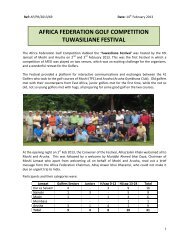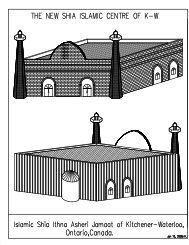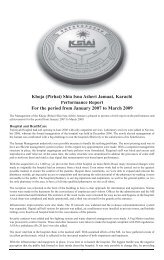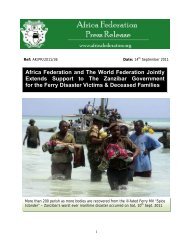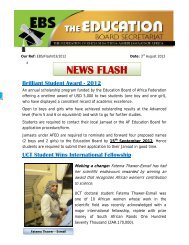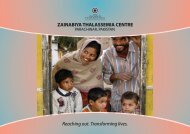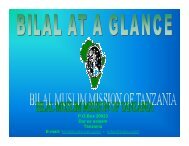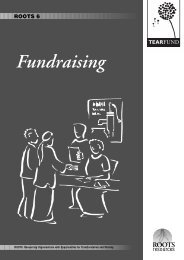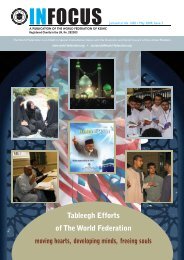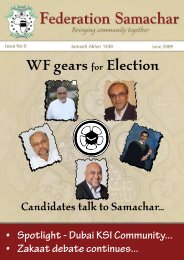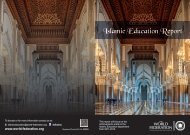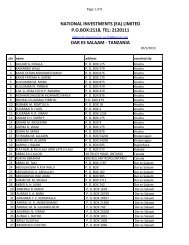Remembering Sayyid Ahmed Badawy Al- Husseiny - The World ...
Remembering Sayyid Ahmed Badawy Al- Husseiny - The World ...
Remembering Sayyid Ahmed Badawy Al- Husseiny - The World ...
Create successful ePaper yourself
Turn your PDF publications into a flip-book with our unique Google optimized e-Paper software.
<strong>Remembering</strong> <strong>Sayyid</strong> <strong>Ahmed</strong> <strong>Badawy</strong> <strong>Al</strong>-<strong>Husseiny</strong>On Wednesday 22nd August, 2012, a well‐known Islamic Scholar, <strong>Sayyid</strong> <strong>Ahmed</strong><strong>Badawy</strong>, author of the Swahili book “Ahlul Kisa”, passed away in Mombasa hospitalafter a short illness. His funeral took place on the same day and was attended bylarge mourners from across section of the Muslim communities.Ancestors<strong>Sayyid</strong> Ahmad <strong>Badawy</strong> Bin Muhammad <strong>Al</strong>‐<strong>Husseiny</strong> was born in 1929 inLamu, Kenya. <strong>Sayyid</strong> <strong>Ahmed</strong> was fondly known locally as Sharif <strong>Ahmed</strong><strong>Badawy</strong>. His ancestors hailed from Comoro Islands and their lineage couldbe traced to the Ulema of Hadaharamut in south Yemen.Education<strong>Sayyid</strong> Ahmad <strong>Badawy</strong>, delivering a lecture at the Bilal Hall, MombasaWhile in Lamu, Sharif <strong>Ahmed</strong> undertook Islamic studies in local Madrassaand took lessons from leading local Ulema, including Sheikhs <strong>Sayyid</strong>Abdulrahman Saggaf.At the age of 21, he left Lamu to settle in Mombasa. While in Mombasa, hetook lessons in advance Islamic Jurisprudence (“Fiqh”), “Aqeeda”, advanceArabic Grammar and “Qaida”, interstate laws and succession laws, under thesupervision of well‐known Aalim, <strong>Sayyid</strong> <strong>Al</strong>i <strong>Badawy</strong>.He also studied additional Islamic subjects from Sharif AbdulrahmanKhitamy, younger brother of <strong>Sayyid</strong> <strong>Al</strong>i <strong>Badawy</strong>.1
While pursuing higher Islamic learning, he conducted lessons in Islamicstudies at local Mosque and later enrolled as a teacher at the MombasaPolytechnic, then known as <strong>The</strong> Mombasa Institute of Muslim Education. Atthe age 26 he went to teach religion briefly to areas near Nairobi.At the age of 30, he studied various Islamic disciplines from Sheikh <strong>Al</strong>‐Breikand Sheikh Muhammad Kassim Mazrui. Among his teachers, the two wellknownlocal Sheikhs, <strong>Sayyid</strong> <strong>Al</strong>i <strong>Badawy</strong> and Sheikh Muhammad KassimMazrui later became Chief Kadhi of Kenya. .His Late FatherFather of <strong>Sayyid</strong> <strong>Ahmed</strong>, <strong>Sayyid</strong> Muhammad <strong>Badawy</strong> was based in Lamu,Kenya. By early 1960’s, he was one of the early indigenous individuals inKenya to publicly adopt the madh’hab of Ahlul Baiyt (A.S.).Whenever visiting Mombasa, <strong>Sayyid</strong> Muhammad would always come to theIthna‐Asheri Mosque for prayers and make it a point to attend Majlis,especially on ‘wiladat’ and ‘wafat’ occasions. Though he did not understandUrdu, he would register his presence on such occasions.At a condolence meeting held at the Bilal Hall, Sheikh Abdillahi Nasserrecalled that <strong>Sayyid</strong> Muhammad would be criticised by individuals forattending Majlis at the Shia Imambara since he did not understand anyIndian language. To this criticism, Sharif Muhammad would politely respond:“I am not an illiterate person. I have read the history of Islam and thereligious texts. While sitting in Majlis, when a Khatib recites a verse from theHoly Quran or quotes a Hadith, I can relate to the subject and draw out theessence of the presentation. Besides, in participating at such functions, atleast, I am blessed with the opportunity to recite Salawat every time thename of the Holy Prophet Muhammad and the Aimmae At’har arementioned.”2
17th October, 1970, on the eve of 15th Shabaan, 1390 A.H., the rebuilt Hyderi Imambara in Mombasawas officially opened. Late <strong>Sayyid</strong> Sharif Muhammad <strong>Badawy</strong> seen here seated in front row secondfrom left. Mulla Asghar is seen addressing the congregation. <strong>Al</strong>so in the photograph arerepresentatives of the community from various East Africa Jamaats. Visible among them are (fromright to left) Ibrahim Ladha Kassam (Kampala), Mohamedali Sharif (Moshi) <strong>Ahmed</strong> Muraj(Mogadishu), H .K.J affer, (Jinja), Mohamedali Meghji (Chairman of the Federation of the K.S.I.Jamaats of Africa, Maulana Sayed Hasan Naqavi, Sayed Mehdi Shushtari, (Zanzibar), <strong>Ahmed</strong> LakhaKanji (Zanzibar), Kassamali Gulamhusein, Abdulrasul Sachedina, (Mombasa), Khurshid <strong>Al</strong>i Sheikh,(Nairobi), Husein Visram, Mulla Kassam (Mombasa). <strong>Al</strong>so seen standing outside to welcome guests isHusein Habib Janmohamed who was closely associated with Mulla Asgharali M. M. Jaffer in the funddrive and in overseeing the construction of the new Imambaghra.In 1970, when the rebuilt Hyderi Imambargha was opened on 13 th<strong>Sayyid</strong> Muhammad travelled from Lamu for the occasion.Rajab,Whenever visiting Mombasa during the months of Muharram, he would alsoparticipate in the Swahili Muharram majlis organised initially at the old BilalOffice when speakers like the former Chief Kadhi of Zanzibar and Kenya thelate Sheikh Abdulla Saleh Farsy and other well‐known local scholars woulddeliver discourses.Lamu and MombasaBefore the growth of Mombasa, Lamu was the major port in Kenya. In 1900,Khoja Shia Ithna‐Asheri population in Lamu was just over 250, compared toMombasa, which then had half this number.With the opening of the Mombasa/Nairobi/Kisumu Railway in 1901 and thecommissioning of Kilindini Port, Mombasa acquired improved economicstatus ushering in a slow decline of Lamu in the process.3
Community members in Lamu intermingled well with the local population.Individuals like Mulla Nanji Bhanji, well versed in Islamic studies, wouldassociate with local scholars and thus help project the Shia faith in betterlight. <strong>The</strong> indigenous Muslims in the East African coastal belt were mostlyShaf’ee. So were the many Arabs from Hadharamut and Yemen. Shaf’ee areknown to be close to Shia in their reverence for the Ahlul Bait.Ahlul KisaIn 1964 <strong>Sayyid</strong> Ahmad <strong>Badawy</strong> wrote the acclaimed book “Ahlul Kisaa”which became very popular in Kenya and Tanzania and helped generategrowing interest in the study of the role of Ahlul Bait.A total of 15,000 copies of this book were published over a period. <strong>The</strong> first editionof 5,000 copies was published in 1964 by the Islamic Research Organization,Mombasa. Bilal Muslim Mission of Tanzania published 5,000 copies each in 1989 and1996.From Left to right. Shariff Muhammad <strong>Badawy</strong>, Shariff AbdulrehmanKhitamy, Mulla Asgharali M. M. Jaffer and Shariff <strong>Ahmed</strong> <strong>Badawy</strong>engaged in animated discussion at the old Bilal Office, Mombasa.4
For many years <strong>Sayyid</strong> Ahmad <strong>Badawy</strong> served as the Imam of Mahuru Mosque in theKibokoni area of Mombasa Island, close to the Hyderi Masjid and Imambara. WhenMahuru Masjid was expanded after renovation, at the opening ceremony, Shariff<strong>Ahmed</strong> spoke on the role of a Masjid and how the Holy prophet (SAWW) and Imam<strong>Al</strong>i (A.S.) used to settle the affairs of Muslims while sitting in the Masjid.Bilal Muslim Mission of Kenya was formed in 1967. By mid 1970’s, Swahilimajlis were arranged during the months of Muhrram at the small Bilal Officeadjascent to the Hyderi Mosque. As attendance for the Swahili majlis wasgrowing, by 1978 the venue for Swahili majlis was shifted to the HuseiniImmabara until the opening of the Bilal House in 1988.<strong>Sayyid</strong> <strong>Ahmed</strong> was one of the regular speakers for the Muharram majlis,along with Sheikh Abdillahi Nasser, Sheikh Sharif Abdulrahman Khitamy, Dr.<strong>Ahmed</strong> Khatib and many well know local individuals. Besides, <strong>Sayyid</strong> <strong>Ahmed</strong>was also a popular speaker at the Meelad‐un‐Nabi and Husein Daygatherings held in Mombasa, Tanga and Nakuru.A humble, unassuming person, quietly dedicating his life in the service ofIslam and in promoting the teachings of Ahlul Baiyt (A.S.) for half a century,the loss of <strong>Sayyid</strong> <strong>Ahmed</strong> <strong>Badawy</strong> will be greatly felt not only by members ofhis immediate family but by many who came in close contact with him overthe years.1976. Mulla Asghar delivering majlis in Kiswahili at Muharram majalis organised byBilal Muslim Mission, Mombasa in their old building. Seen in the picture areMr.Mohamedli Chandoo, Sharif Mohamed Badaway, Sharif Khitamy, Haji <strong>Al</strong>iMohamed Jaffer. Sharif <strong>Ahmed</strong> <strong>Badawy</strong>, Hasan Nazerali, Hussein Shariff Khalfan.5
At Bilal Hall, Mombasa seen here seated are Shariff <strong>Ahmed</strong><strong>Badawy</strong>, Shariff Abdurehman Khitamy, Late Haji <strong>Al</strong>i MohamedJaffer and others.We send our heartfelt condolences to the family, friends and all thecommunity members on the sad demise of <strong>Sayyid</strong> <strong>Ahmed</strong> <strong>Badawy</strong> <strong>Al</strong>‐<strong>Husseiny</strong>.May <strong>Al</strong>lah, in His Mercy grant him maghferat and place marhum in highabode in the Jaware Ahlul Baiyt (A.S.) Ameen.Please remember marhum with Sura‐e‐Fateha.SecretariatBILAL MUSLIM MISSION OF KENYAMOMBASA, KENYA6



